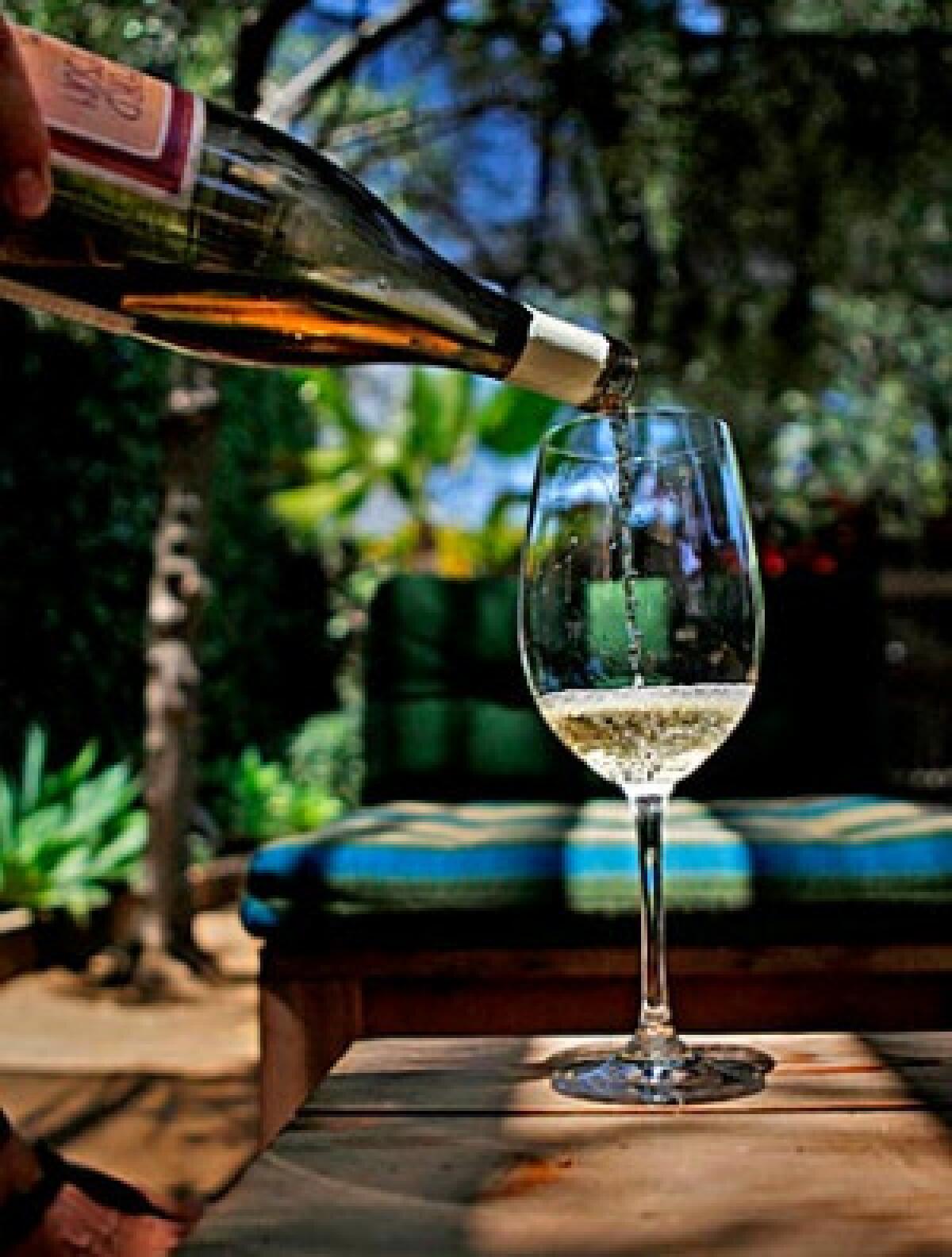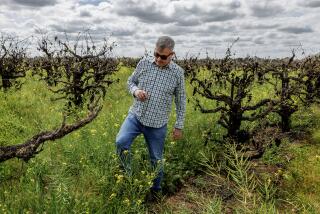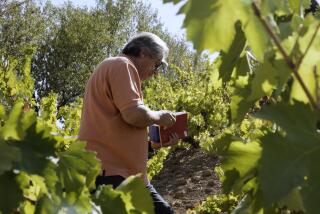White wines at the ready for summer

Despite summer’s reluctance thus far to make a lasting appearance, there soon will be plenty of gatherings by the pool, picnics at the Bowl and alfresco meals under a panoply of patio umbrellas. The superstars of summer produce — peaches, cherries, tomatoes, peas, haricots verts, sweet corn — will each flounce onto the stage during its glorious window of peak ripeness, meaning that now’s the time to assemble a working case of summer white wines, to meet the onslaught.
I’ve heard it said that a good summer wine is like sunshine in a bottle. There’s some truth to that: The ideal wine will have the brilliant, drip-down-your-chin succulence of freshly picked fruit, as unadorned as a cloudless sky. But it’s probably more accurate to say that a good summer wine is sunshine’s foil, capable of turning back the day’s dazzling heat with the cut of its coolness, the quenching prickle of its acidity, the bite of its finish.
A summer wine’s greatest strength, in short, is its angularity. The flavors can be bold and forward, but rather than length, these wines possess a glancing, oblique feel in the mouth, a textural concision that leaves one’s thirst quenched and mouth watering, expectant of another sip. Here are some strategies for filling a working case.
The leanest and meanest
Let’s start our working case by identifying a few of the leanest and meanest whites a given region or country has to offer.
In Australia, for example, Riesling wins that contest hands down. In fact, Australian Riesling might be the driest, most searing expression of that grape in the world, with a thrilling, pulsing acidity in the service of citrus, lime and grapefruit flavors. The standard-bearer remains Grosset Polish Hill ($35); but seek out Pewsey Vale ($15), Leasinghams ($12) and Frankland Estate (about $25) as well.
In France the contest would be held on at least two coastlines. On the Atlantic side, bragging rights fall to Muscadet sur Sevre et Main sur Lie (Muscadet for short). Muscadets are known for their brisk salinity, ideal with the one food it was put on this Earth to accompany: oysters. Heaven. Two of my favorites: Luneau-Papin’s “Le L d’Or” or Domaine de la Pepière’s “Clos des Briords” (both about $18).
Muscadets are rivaled in the south by a seaside appellation in Languedoc called Picpoul de Pinet, which employs a slow-to-ripen white grape by the same name. Picpoul is grown in the Rhône Valley as well, but only in vineyards by the sea does the grape have such a refreshing, lemony nerve, and yes, these wines are also heavenly with oysters or something like squid off the grill. Look for affordable Picpouls from Arnaud Gaujol and La Croix Gratiot (both about $12).
Certainly Austrian whites are among the most limpid, racy wines on the continent. Rieslings and Gruner Veltliners offer edgy, laser-focused textures and herbaceous flavors, tremendous attributes for meals made from the best summer produce. And there is a fairly new-to-market category of Gemischter Satz blends from wineries in and around Vienna, the staples of the city’s Heurige (wine bars). These are surprisingly complex and versatile wines, such as the one I found from Weingut Christ (about $18).
For lean and mean in the U.S., the competition stiffens. Cooler climes such as Oregon are a safe bet, where many (but not all) Pinot Gris bottlings fill the bill as crisp and delineated whites. Two are King Estate’s Signature bottling (about $15) or the better-than-average “Really Good Pinot Gris” from Joe Dobbes ($18).
American Riesling too is getting more and more edgy, especially in Washington state, such as the organic Wallula Vineyard bottling from Pacific Rim and the limpid, poised Riesling produced in partnership with Ernst Loosen and Chateau Ste. Michelle called “Eroica” (both about $20). And Ste. Michelle’s Columbia Valley Dry Riesling is a steal at $9.
Meanwhile in California, Vermentino, one of the varieties that Tablas Creek imported from the Rhône Valley (where it is known as Rolle) has made modest inroads. One of the best is L’Uvaggio del Giacomo, an orange-scented beauty that retails for about $13. And Edmunds St. John uses the variety in his lean “Heart of Gold,” blended with Grenache Blanc (about $18).
In a Mediterranean mood
Probably no region on Earth embodies summer better than the Mediterranean. In outdoor cafes and on beaches from Costa Brava to Kalamata, Mediterranean culture seems drenched in sunlight, and for each port of call there are several white wines on hand to quench thirsts.
Nearly every white wine in Greece serves this purpose; indeed Boutari, its largest wine company, has about a dozen by itself, but their nervy Moschofilero (about $16) or their sun-kissed blend from the island of Santorini (about $20) are worth grabbing. From Santorini, look for the wines from Gaia and Sigalas as well. In the north, meanwhile, is grown the beautiful Roditis called Petra and made by Kir-Yianni (about $20), which has just returned to the market after a brief absence; beautiful flavors of pine and lemon make this wine ideal for grilled seafood.
Italy has more than its share of summery whites to choose from. For a sunny day there is no safer bet than one of the three Vs: Verdicchio, Vernaccia and Vermentino.
Of the three, I am at the moment most haunted by Verdicchio di Matelica, with its bright citrus scents, high natural acidity and the sunny warmth of its flavors, from the likes of Colle Stefano (about $15). A Vernaccia from, say, San Quirico or Panizzi (about $15), from vineyards in and around the picturesque town of San Gimignano, has a more mineral firmness than Verdicchio, with flavors of brisk lime and green apples tailor-made for crudo. Or pour yourself a glass of “Costamolino,” the Sardinian Vermentino from Argiolas, with its golden hue and sharp flavors of ginger and sea salt (about $17); Mancini’s Vermentino di Gallura has a bit more give to its texture (about $15).
Sauvignons of the world
For global ubiquity, no summer wine outdoes Sauvignon Blanc. While its worldwide acreage is still dwarfed by Chardonnay, Sauvignon Blanc has become a benchmark for lean whites from every hemisphere, from Napa to Chile, from France to New Zealand.
New Zealand Sauvignons have set the standard in recent years for crisp herbaceousness, such as the ever-reliable Kim Crawford, or the newer offering Wild Rock (both about $14). In Australia, the Sauvignons sometimes come spiked with Semillon to broaden their palate weight and add a grassy note, especially those from Western Australia, such as Plantaganet’s Hazard Hill bottling (about $10).
The incredible Sauvignon Blancs of Chile lean more toward marine, saline flavors, such as those from Montes and Veramonte (about $12). Of course, the vibrant whites of the Loire are in many ways responsible for these many deserving pretenders, in particular the wines of Sancerre with their chalky, talc-like firmness, such as Sylvain Bailly’s “Terroirs” bottling (about $21).
In California, more than ever, producers are fermenting in steel tanks to retain fruit freshness and bright acidity. One of the country’s most reliable comes from Honig, in the Napa Valley; other worthy Napa producers include Cliff Lede and St. Supery; from Sonoma, seek out Quivira or Kunde (all between $15 and $20).
In a category all its own: Moscato d’Asti
As fresh stone fruit reaches the market in abundance, leave room in your working case for one dessert wine, an Italian Moscato d’Asti. Made by venerable Piedmont producers such as Vietti, Chiarlo or G.D. Vajra (about $15), there simply isn’t a more glorious accompaniment to summer fruit plates than this fizzy sweet wine, redolent of peaches, orange zest and minerals. With their exuberant effervescence and sunny disposition, they’re practically the most mood-altering, happy-making wine I know, and that’s everything a summer white should be.
More to Read
Eat your way across L.A.
Get our weekly Tasting Notes newsletter for reviews, news and more.
You may occasionally receive promotional content from the Los Angeles Times.










